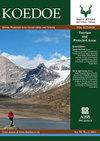人园双赢框架:整合影响人园关系的要素
IF 1.1
4区 环境科学与生态学
Q3 BIODIVERSITY CONSERVATION
引用次数: 1
摘要
保护区周围往往是贫困社区。必须在改善社区福祉的同时保护生物多样性。需要更深入地了解是什么影响了这些社区中支持保护的态度和行为。很多事情似乎取决于保护区工作人员和公园周围当地社区之间的关系,但对利益相关者的看法以及如何务实地实现双赢解决方案的理解有限。由于目前缺乏一个多维框架来加强对这种复杂和动态关系的理解,本研究旨在构建一个综合的集成框架,代表可以影响人与公园关系的组成部分。该框架是通过三方面的方法构建的,即更广泛的文献综述,对现有模式的重点研究,以及对南非三个不同保护区附近三个当地社区的态度和行为的初步研究。由此产生的人民公园双赢框架由四个层面组成(每个层面都有自己的组成部分):“外部环境”、“利益相关者”、“社区受益”和“产出”。其独特的安排侧重于受益,包括更多利益相关者及其特征,关系的中心性和产出的展示(前几层如何达到双赢,以及支持保护的态度和行为如何适应这一点)。为利益相关者提供了一个简化的框架,以便他们将自己的特点、利益、影响和受益原则叠加在一起。这项研究借鉴了其他人的工作以及初步研究,以建立这个多维框架,捕捉对人与公园关系的影响,重点是实现社区福祉和生物多样性保护。保护意义:社区福祉和生物多样性保护的双赢是复杂的。然而,存在有形和无形收益的潜力,这可以培养积极的态度,从而促进保护行为和公园与邻近社区之间强有力的互惠关系。为此,该框架为保护区管理者和参与人与公园关系的利益相关者提供了一个实用工具,可以根据特定情况进行定制。本文章由计算机程序翻译,如有差异,请以英文原文为准。
People Parks Win-Win Framework: Integrating components that can influence people-park relationships
Protected areas are often surrounded by impoverished communities. Biodiversity must be conserved while improving community well-being. Greater insight is required into what influences pro-conservation attitudes and behaviour in these communities. Much appears to rest on the relationships between protected area staff and local communities surrounding the parks, yet there is limited understanding of stakeholders’ perceptions and how to pragmatically achieve win-win solutions. With the current lack of a multidimensional framework to enhance understanding of this complex and dynamic relationships, this research aimed to construct a comprehensive integrated framework representing the components that can influence people-park relationships. The framework was constructed via a threefold approach, namely a broader literature review, a focused study of existing schemata and primary research regarding the attitudes and behaviour of three local communities bordering three different protected areas in South Africa. The resultant People Parks Win-Win Framework consists of four layers (each with its own components): ‘External context’, ‘Stakeholders’, ‘Community beneficiation’ and ‘Outputs’. Its unique arrangement focuses on beneficiation, inclusion of more stakeholders and their characteristics, the centrality of relationships and demonstration of outputs (how preceding layers can culminate in win-wins and how pro-conservation attitudes and behaviour fit into this). A simplified framework is also provided, for stakeholders to superimpose their own characteristics, benefits, influences and beneficiation principles. This research draws on the work of others as well as primary research to produce this multidimensional framework capturing the influences on people-park relationships with a focus on achieving both community well-being and biodiversity conservation.Conservation implications: Win-wins for community well-being and biodiversity conservation are complex. Yet potential exists for tangible and intangible beneficiation, which can foster positive attitudes resulting in pro-conservation behaviour and robust reciprocate relationships between parks and neighbouring communities. To this end, the framework serves as a practical tool for protected area managers and stakeholders involved in the people-park relationships, which can be customised to particular contexts.
求助全文
通过发布文献求助,成功后即可免费获取论文全文。
去求助
来源期刊

Koedoe
BIODIVERSITY CONSERVATION-
CiteScore
3.30
自引率
0.00%
发文量
10
审稿时长
20 weeks
期刊介绍:
Koedoe, with the subtitle ''African Protected Area Conservation and Science'', promotes and contributes to the scientific (biological) and environmental (ecological and biodiversity) conservation practices of Africa by defining the key disciplines that will ensure the existence of a wide variety of plant and animal species in their natural environments (biological diversity) in Africa.
 求助内容:
求助内容: 应助结果提醒方式:
应助结果提醒方式:


